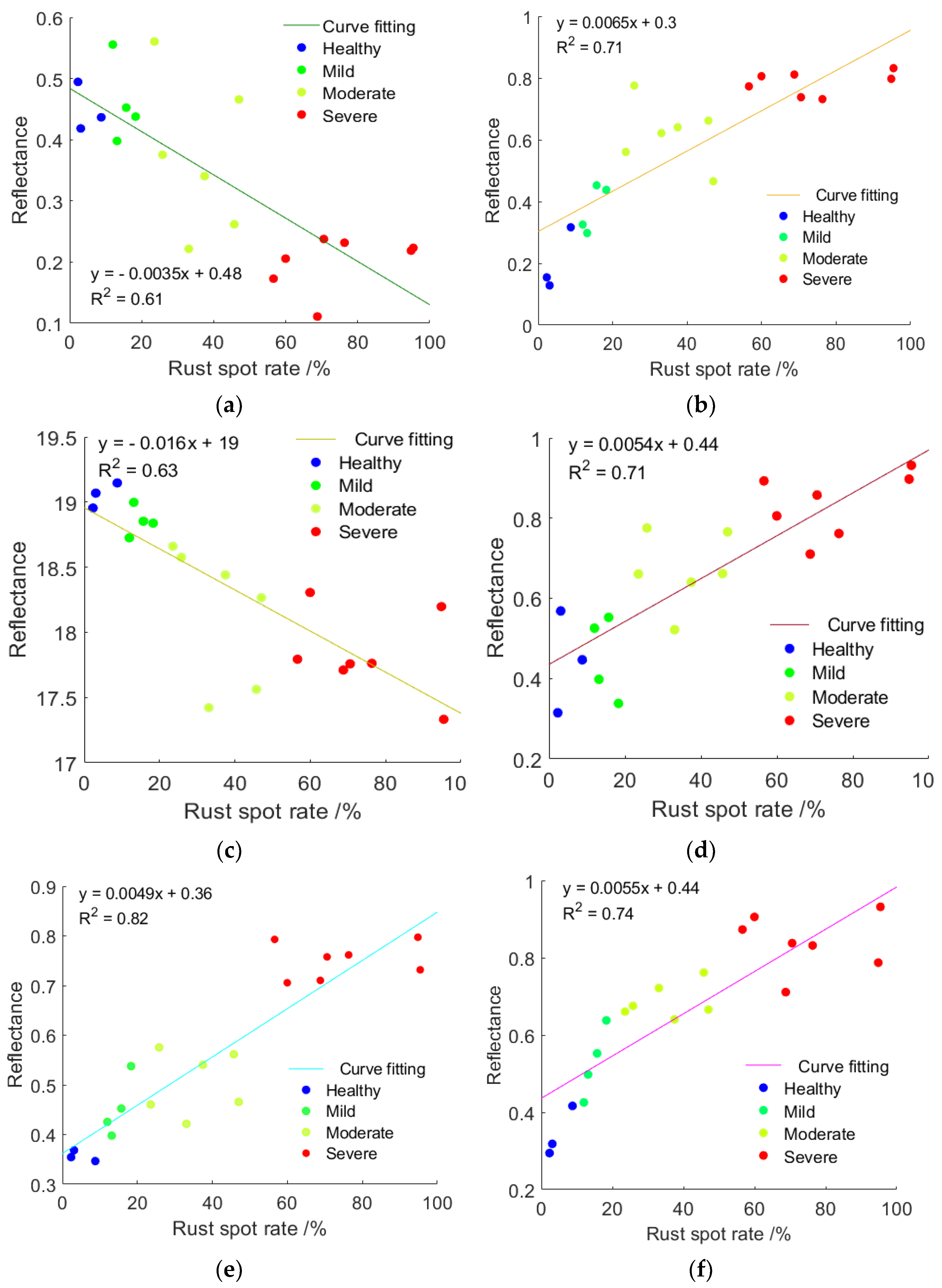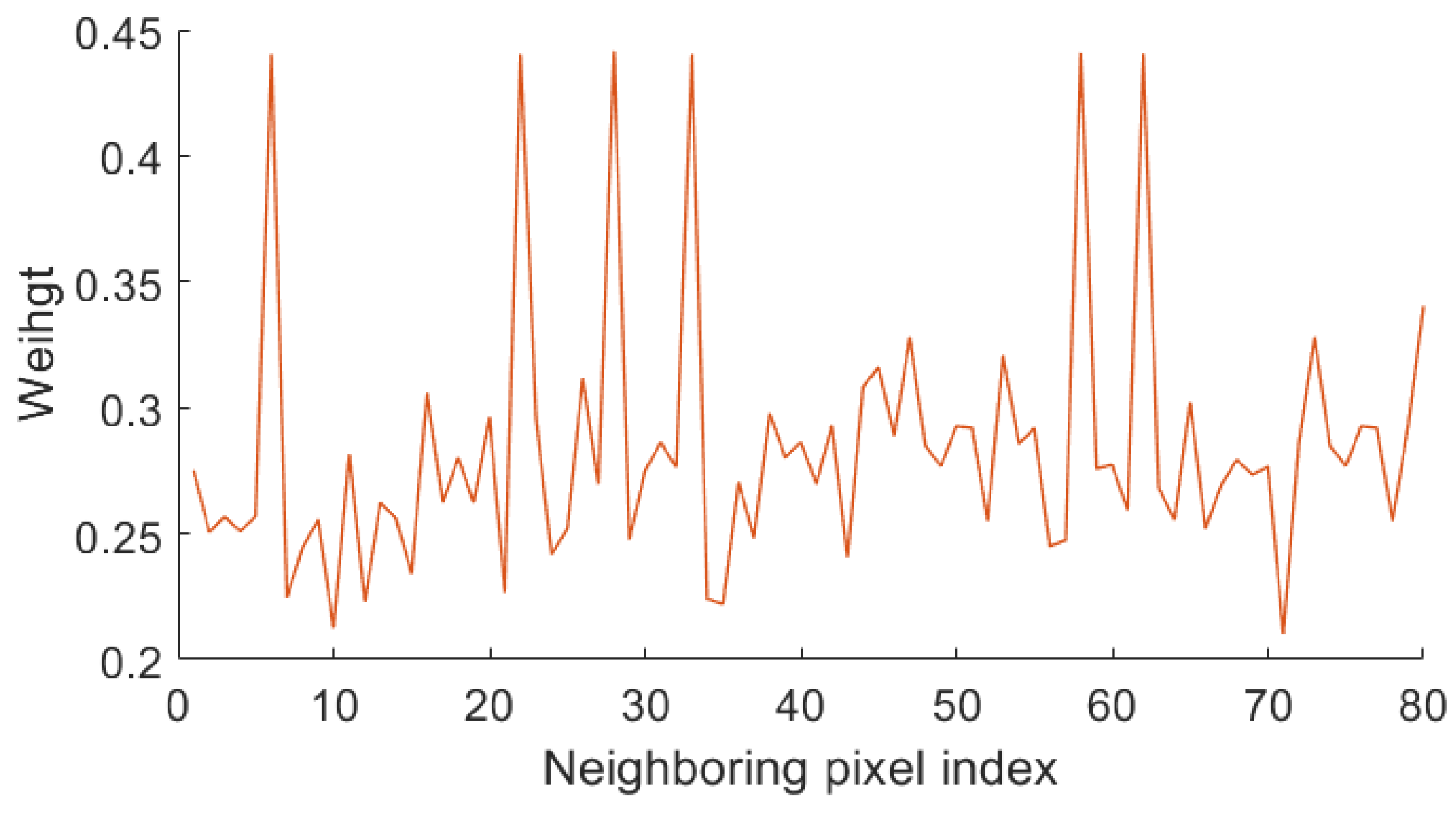Prediction of Thrips Damage Distribution in Mango Orchards Using a Novel Maximum Likelihood Classifier
Abstract
:1. Introduction
2. Materials and Methods
2.1. Experimental Site
2.2. Drone Remote Sensing System and Data Acquisition
2.3. Classification of Mango Thrips Damage Levels
2.4. Feature Wavelength Extraction
2.5. Vegetation Index Construction
2.6. Prediction Model of Mango Thrips Leaf Damage Degree Based on the Novel MLC
3. Results
3.1. Correlation Analysis of Different Vegetation Indices and Pest Infestation Levels
3.2. Analysis of Performance Testing Results of the Novel MLC
3.3. Analysis of Predicted Distribution Results of Thrips Levels
4. Discussion
5. Conclusions
Author Contributions
Funding
Institutional Review Board Statement
Informed Consent Statement
Data Availability Statement
Conflicts of Interest
References
- Manhongo, M.M.; Chimphango, A.; Thornley, P.; Röder, M. Techno-economic and environmental evaluation of integrated mango waste biorefineries. J. Clean. Prod. 2021, 325, 129335. [Google Scholar] [CrossRef]
- Venkata, R.R.P.; Gundappa, B.; Chakravarthy, A.K. Pests of mango. In Pests and Their Management; Springer: Singapore, 2018; pp. 415–440. [Google Scholar]
- Han, D.Y.; Li, L.; Niu, L.; Chen, J.; Zhang, F.; Ding, S.; Fu, Y. Spatial Distribution Pattern and Sampling of Thrips on Mango Trees. Chin. J. Trop. Crops 2019, 40, 323–327. [Google Scholar]
- Renzullo, L.J.; Blanchfield, A.L.; Powell, K.S. Insights into the early detection of grapevine phylloxera from in situ hyperspectral data. Acta Hortic. 2007, 733, 59–74. [Google Scholar] [CrossRef]
- Mei, H.; Deng, X.; Hong, T.; Luo, X. Early detection and grading of citrus Huanglongbing using hyperspectral imaging technique. Trans. Chin. Soc. Agric. Eng. (Trans. CSAE) 2014, 30, 140–147. [Google Scholar]
- Deng, X.; Lan, Y.; Hong, T.; Chen, J. Citrus greening detection using visible spectrum imaging and C-SVC. Comput. Electron. Agric. 2016, 130, 177–183. [Google Scholar] [CrossRef]
- Carlos, E.C.A.; Leonardo, A.R.; Flavio, A.O. Spectral analysis for the early detection of anthracnose in fruits of Sugar Mango (Mangifera indica). Comput. Electron. Agric. 2020, 173, 105357. [Google Scholar]
- Luo, Q.; Huang, T.; Chen, S.; Chen, M.; Jia, X.; Zhu, X.; Lai, F.; Wu, H.; Zhao, W.; Li, C.; et al. Quantitative evaluation of Sewei apple insect damage levels based on spectral reflectance. J. Jiangsu Agric. 2019, 35, 798–803. [Google Scholar]
- Zheng, B.; Chen, Y.; Li, K.; Wang, X.; Xu, Z.; Huang, X.; Hu, X. Detection of Pest Degree of Phyllostachys Chinese with Hyperspectral Data. Spectrosc. Spectr. Anal. 2021, 41, 3200–3207. [Google Scholar]
- Ma, Y.; Li, Y.; Liu, M.; Shi, L.; Zhang, J.; Zhang, Z. Harm Monitoring and Inversion Study on Tomicus yunnanensis Based on Multispectral Image of Unmanned Aerial Vehicle. Southwest. China J. Agric. Sci. 2021, 34, 1878–1884. [Google Scholar]
- Roope, N.; Honkavaara, E.; Blomqvist, M.; Päivi, L.; Teemu, H.; Niko, V.; Tuula, K.; Markus, H. Remote sensing of bark beetle damage in urban forests at individual tree level using a novel hyperspectral camera from UAV and aircraft. Urban For. Urban Green. 2018, 1, 72–83. [Google Scholar]
- Marston, Z.P.D.; Cira, T.M.; Hodgson, E.W.; Knight, J.F.; MacRae, I.V.; Koch, R.L. Detection of damage induced by soybean aphid (Hemiptera: Aphididae) using multispectral imagery from unmanned aerial vehicles. J. Econ. Entomol. 2020, 113, 779. [Google Scholar] [CrossRef]
- Frazier, P.; Whiting, J.; Powell, K.; Lamb, D. Characterising the development of grape phylloxera infestation with multi-temporal near-infrared aerial photography. Aust. N. Z. Grapegrow. Winemak. 2004, 485, 133–136. [Google Scholar]
- Shi, Y.; Huang, W.; Luo, J.; Huang, L.; Zhou, X. Detection and discrimination of pests and diseases in winter wheat based on spectral indices and kernel discriminant analysis. Comput. Electron. Agric. 2017, 141, 171–180. [Google Scholar] [CrossRef]
- Elbeih, S.F.; El-Zeiny, A.M. Qualitative assessment of groundwater quality based on land use spectral retrieved indices: Case study Sohag Governorate, Egypt. Rem. Sens. Appl. Soc. Environ. 2018, 10, 82–92. [Google Scholar] [CrossRef]
- Xu, Z.; Li, B.; Yu, H.; Zhang, H.; Guo, X.; Li, Z.; Wang, L.; Liu, Z.; Li, Y.; He, A.; et al. Changing Relationships between Water Content and Spectral Features in Moso Bamboo Leaves under Pantana phyllostachysae Chao damage. Forests 2023, 14, 702. [Google Scholar] [CrossRef]
- Bian, C.; Shi, H.; Wu, S.; Zhang, K.; Wei, M.; Zhao, Y.; Sun, Y.; Zhuang, H.; Zhang, X.; Chen, S. Prediction of Field-Scale Wheat Yield Using Machine Learning Method and Multi-Spectral UAV Data. Remote Sens. 2022, 14, 1474. [Google Scholar] [CrossRef]
- Chen, X.; Dong, Z.; Liu, J.; Wang, H.; Zhang, Y.; Chen, T.; Du, Y.; Shao, L.; Xie, J. Hyperspectral characteristics and quantitative analysis of leaf chlorophyll by reflectance spectroscopy based on a genetic algorithm in combination with partial least squares regression. Spectrochim. Acta Part A Mol. Biomol. Spectrosc. 2020, 243. [Google Scholar] [CrossRef] [PubMed]
- Tao, W.; Wang, X.; Xue, J.H.; Su, W.; Zhang, M.; Yin, D.; Zhu, D.; Xie, Z.; Zhang, Y. Monitoring the damage of armyworm as a pest in summer corn by unmanned aerial vehicle imaging. Pest Manag. Sci. 2022, 78, 2265–2276. [Google Scholar] [CrossRef] [PubMed]
- Melgani, F.; Bruzzone, L. Classification of hyperspectral remote sensing images with support vector machines. IEEE Trans. Geosci. Remote Sens. 2004, 42, 1778–1790. [Google Scholar] [CrossRef]
- Zhong, Y.; Zhang, L. An adaptive artificial immune network for supervised classification of multi-hyperspectral remote sensing imagery. IEEE Trans. Geosci. Remote Sens. 2011, 50, 894–909. [Google Scholar] [CrossRef]
- Li, J.; Bioucas-Dias, J.M.; Plaza, A. Semisupervised hyperspectral image classification using soft sparse multinomial logistic regression. IEEE Geosci. Remote Sens. Lett. 2012, 10, 318–322. [Google Scholar]
- Banlawe, I.A.P.; Cruz, J.C.D.; Gaspar, J.C.P.; Gutierrez, E.J.I. Decision Tree Learning Algorithm and Naïve Bayes Classifier Algorithm Comparative Classification for Mango Pulp Weevil Mating Activity. In Proceedings of the 2021 IEEE International Conference on Automatic Control & Intelligent Systems (I2CACIS), Shah Alam, Malaysia, 26 June 2021; pp. 317–322. [Google Scholar]
- Sifiso, X.; Nkanyiso, M.; Kabir, P.; Michael, G.; Naeem, A. Comparison of different spectral indices to differentiate the impact of insect attack on planted forest stands. Remote Sens. Appl. Soc. Environ. 2024, 33, 101087. [Google Scholar]
- Li, P.; Huang, X.; Yin, S.; Bao, Y.; Bao, G.; Tong, S.; Dashzeveg, G.; Nanzad, T.; Dorjsuren, A.; Enkhnasan, D.; et al. Optimizing spectral index to estimate the relative chlorophyll content of the forest under the damage of Erannis jacobsoni Djak in Mongolia. Ecol. Indic. 2023, 154, 110714. [Google Scholar] [CrossRef]
- Berger, K.; Machwitz, M.; Kycko, M.; Kefauver, S.C.; Van Wittenberghe, S.; Gerhards, M.; Verrelst, J.; Atzberger, C.; Van der Tol, C.; Damm, A.; et al. Multi-sensor spectral synergies for crop damage detection and monitoring in the optical domain: A review. Remote Sens. Environ. 2022, 280, 113198. [Google Scholar] [CrossRef] [PubMed]
- Lin, X.; Sun, J.; Yang, L.; Liu, H.; Wang, T.; Zhao, H. Application of UAV Multispectral Remote Sensing to Monitor Damage Level of Leaf-feeding Insect Pests of Oak. J. Northeast. For. Univ. 2023, 51, 138–144. [Google Scholar]
- Chen, S.; Webb, G.I.; Liu, L.; Ma, X. A novel selective naïve Bayes algorithm. Knowl.-Based Syst. 2020, 192, 105361. [Google Scholar] [CrossRef]
- Peng, J.; Li, L.; Tang, Y.Y. Maximum Likelihood Estimation-Based Joint Sparse Representation for the Classification of Hyperspectral Remote Sensing Images. IEEE Trans. Neural Netw. Learn. Syst. 2018, 30, 1790–1802. [Google Scholar] [CrossRef]
- Camps-Valls, G.; Gomez-Chova, L.; Muñoz-Marí, J.; Vila-Francés, J.; Calpe-Maravilla, J. Composite kernels for hyperspectral image classification. IEEE Geosci. Remote Sens. Lett. 2006, 3, 93–97. [Google Scholar] [CrossRef]
- Chen, Y.; Nasrabadi, N.M.; Tran, T.D. Hyperspectral image classification using dictionary-based sparse representation. IEEE Trans. Geosci. Remote Sens. 2011, 49, 3973–3985. [Google Scholar] [CrossRef]
- Zou, J.; Li, W.; Huang, X.; Du, Q. Classification of hyperspectral urban data using adaptive simultaneous orthogonal matching pursuit. J. Appl. Remote Sens. 2014, 8, 085099. [Google Scholar] [CrossRef]








| Levels | Sample Size | Rust Spot Rate/% |
|---|---|---|
| severe | 35 | 51~100 |
| moderate | 30 | 21~50 |
| mild | 20 | 11~20 |
| healthy | 15 | 0~10 |
| Vegetation Index | Formula | Source |
|---|---|---|
| NDVI | [10,24] | |
| EVI | [24] | |
| SAV | [16] | |
| IC | [13,25] | |
| VDV | [8,26] | |
| RGR | [26] | |
| NGRD | [8,10] | |
| EXG | [27] | |
| EXGR | [27] | |
| CIVE | [11,27] | |
| DV | [12,27] | |
| GNDVI | [10,27] | |
| NDG | [27] | |
| WDRV | [26,27] |
| Vegetation Index | p | Vegetation Index | p | ||
|---|---|---|---|---|---|
| NDVI | 0.61 | 0 * | EXG | 0.26 | 0.142 |
| EVI | 0.37 | 0.150 | EXGR | 0.57 | 0.019 * |
| SAV | 0.71 | 0.006 * | CIVE | 0.63 | 0.040 * |
| IC | 0.30 | 0.481 | DV | 0.41 | 0.524 |
| VDV | 0.57 | 0.002 * | GNDVI | 0.81 | 0.045 * |
| RGR | 0.37 | 0 * | NDG | 0.74 | 0.876 |
| NGRD | 0.71 | 0 * | WDRV | 0.55 | 0.001 * |
| Levels | SVM | JSR | ASOMP | MLC | Ours |
|---|---|---|---|---|---|
| severe | 62.45% | 74.56% | 68.56% | 85.47% | 90.17% |
| moderate | 67.89% | 77.14% | 70.15% | 88.69% | 93.11% |
| mild | 66.54% | 69.41% | 74.17% | 88.21% | 91.57% |
| healthy | 69.01% | 70.55% | 79.00% | 90.78% | 90.05% |
| Sampling Time | Healthy | Mild | Moderate | Severe | ||||
|---|---|---|---|---|---|---|---|---|
| Proportion/% | Proportion/% | Proportion/% | Proportion/% | |||||
| 2023.09.18 | 1042.6 | 28.4 | 1387.4 | 37.9 | 845.1 | 23.1 | 384.7 | 10.5 |
| 2024.01.04 | 405.7 | 10.8 | 1155.4 | 31.5 | 987.0 | 26.9 | 1111.7 | 30.8 |
Disclaimer/Publisher’s Note: The statements, opinions and data contained in all publications are solely those of the individual author(s) and contributor(s) and not of MDPI and/or the editor(s). MDPI and/or the editor(s) disclaim responsibility for any injury to people or property resulting from any ideas, methods, instructions or products referred to in the content. |
© 2024 by the authors. Licensee MDPI, Basel, Switzerland. This article is an open access article distributed under the terms and conditions of the Creative Commons Attribution (CC BY) license (https://creativecommons.org/licenses/by/4.0/).
Share and Cite
Wang, L.; Tang, Y.; Liu, Z.; Zheng, M.; Shi, W.; Li, J.; He, X. Prediction of Thrips Damage Distribution in Mango Orchards Using a Novel Maximum Likelihood Classifier. Agronomy 2024, 14, 795. https://doi.org/10.3390/agronomy14040795
Wang L, Tang Y, Liu Z, Zheng M, Shi W, Li J, He X. Prediction of Thrips Damage Distribution in Mango Orchards Using a Novel Maximum Likelihood Classifier. Agronomy. 2024; 14(4):795. https://doi.org/10.3390/agronomy14040795
Chicago/Turabian StyleWang, Linhui, Yonghong Tang, Zhizhuang Liu, Mianpeng Zheng, Wangpeng Shi, Jiachong Li, and Xiongkui He. 2024. "Prediction of Thrips Damage Distribution in Mango Orchards Using a Novel Maximum Likelihood Classifier" Agronomy 14, no. 4: 795. https://doi.org/10.3390/agronomy14040795






